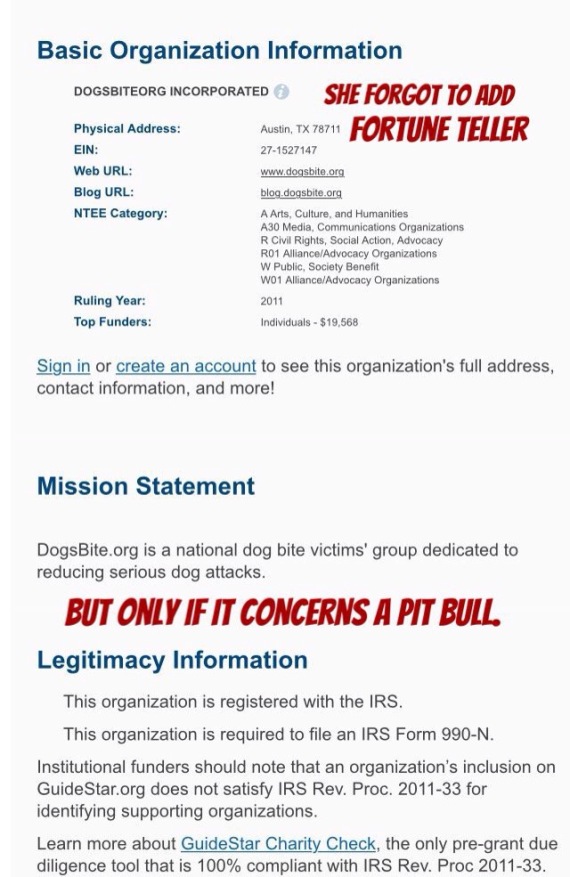Here's a great read on
BSL and the Bull$hit stats from Dogbite.org
This is the same article that appears in the 2010 winter issue of the
APBT Gazette. If you haven't been checking out
www.NoPitBullBans.com go there now. Lot of great information.
Dogsbite.org, a blog dedicated to fostering hysteria about “pit bulls.” We have little mentioned the now infamous dogsbite.org because we didn’t think we had to. Honestly, we couldn’t conceive of anyone taking them or their witch hunt seriously. Their website is so poorly written and their “evidence” so spotty, we honestly didn’t think any elected official would actually stoop to cite their laughable “evidence” as reason to pass breed-specific legislation (
BSL). Well, we were wrong, but luckily not terribly wrong since many politicos and the mainstream media appear to have wisely steered clear of dogsbite.org. Still, the fact that any municipal government – and there have been a few – or the media would cite dogsbite.org with a straight face is a little alarming. So, let’s endeavor to do what has long been overdue: debunk dogsbite.org.
Forget for a moment that many court venues have ruled breed-specific legislation (
BSL) unconstitutional or otherwise unlawful, the most recent being a January ruling in Toledo which declared Toledo’s
BSL beyond the purview of home rule power. But what about all the worldwide evidence that
BSL doesn’t work? For instance, Italy (article 1 and article 2) and the Netherlands both repealed their
BSL within the last couple of years citing its ineffectiveness. It has also been widely reported in the BBC that the UK’s 1991 Dangerous Dog Act has been a phenomenal failure since there has been a huge rise in banned breeds in the UK. And just last month, the Toronto Humane Society, in a survey of cities, released statistics revealing that “Ontario’s 2005 ban on “pit bull” breeds or dogs that resemble pit bulls has not made any difference in the number of dog bites.”
Now I would call the Toronto Humane Society’s findings a pretty good indicator that Toronto’s “pit bull” ban is ineffective since the ban didn’t accomplish what it set out to do: reduce dog bites. Yet dogsbite.org appears to see it differently based on their inclusion of Toronto in a list of supposedly successful BSL cities (this from their rather vague June 21 “press release“):On June 18, DogsBite.org, a national dog bite victims’ group dedicated to reducing serious dog attacks, released data of municipalities across the country, and one instance in Canada [meaning Toronto], that showed the successful results a municipality experiences after adopting a breed-specific pit bull law. The data was gathered over a two-year period when instances appeared in news alerts designed to capture U.S. media reported pit bull attacks.Just to follow through with the Toronto findings, does dogsbite.org mean to say that Toronto’s breed ban has been successful even though the Toronto Humane Society has shown that there are no fewer dog bites???
"SHOOTIN' INJUNS" (OUR GANG SILENT SHORT)~1925
(FEATURING PAL THE DOG)
Dogsbite.org does not explain the discrepancy between their “data” and the Toronto Humane Society’s survey, at least, not in their June 21, 2010 “press release.” Still, we can completely debunk their “data” right out of the gate simply by noting that their “data” got its source from “news alerts” of “pit bull” attacks. Google Alerts can be a nifty tool, but it probably wouldn’t be prudent to base life-altering legislation on it. Indeed, as the widely debunked report Breeds of dogs involved in fatal human attacks in the United States between 1979 and 1998 based on CDC bite data revealed,
..to the extent that attacks by 1 breed are more newsworthy than those by other breeds, our methods may have resulted in differential ascertainment of fatalities by breed. (JAVMA, Vol 217, No. 6, September 15, 2000, p. 838).
In other words, and as the CDC itself acknowledges, media reports are skewed and therefore meaningless because “pit bull” attacks are more “newsworthy.”
Additionally, it has always seemingly escaped dogsbite.org’s attention that “pit bull” is not a breed but a slang term describing countless breeds, their mixes, and those dogs resembling those breeds and their mixes; dogs that are merely “guilty” of fitting a type. (Even dogsbite.org refers to them as “pit bull type dogs” meaning the term “pit bull” does not comprise one breed even by their own assessment!) I say countless breeds have been fingered as “pit bulls” because to some even Chihuahuas look like “pit bulls,” so who knows how many breeds, their mixes, and those dogs sharing an unfortunate resemblance to those breeds and mixes, fall under the category “pit bull”?
ORIGINAL PETE THE PUP (1924-JUNE, 1930)
And does it not follow that if you have a conglomeration of breeds and mixes that you erroneously designate as one breed — the “pit bull” — that it would appear, though falsely, that this “breed” “pit bull” were more inclined to attack? However, parse out actual breeds from those bite statistics and based on population size, what you would find is that no one breed is more inclined to bite or kill than another. This is why we say there is no such thing as an inherently vicious or dangerous breed of dog. Yet still, these unfortunate, innocent dogs are marked for death when “pit bull” grim reapers like dogsbite.org crusade for their slaughter using incredibly flawed data-gathering methods.
As the CDC itself noted of its own statistics, 1) the media is notorious for reporting almost exclusively on so-called “pit bull” attacks, 2) the media is notorious for getting the breed wrong, which they always will if they refer to the dog in question as a “pit bull,” 3) the statistics do not take into consideration mitigating factors like owner irresponsibility, abuse or neglect, lack of socialization, etc. and 4) CDC statistics are inconclusive because they are not based on what the CDC calls “reliable breed-specific population data.” Breed-specific population data is just that: accurate numbers of the population of dogs by breed. Therefore, if “pit bull” is not a breed but a type, which the CDC itself acknowledges, then accurate population data for “pit bulls” would be impossible to determine, which is why the CDC’s own findings were rendered meaningless, again as the CDC itself acknowledged.
ORIGINAL PETE THE PUP (1924-JUNE, 1930)
One must conclude from the CDC study that in order to take dog-bite data seriously, one must be able to discern the proper breed based on more than mere media reports, one must factor in mitigating circumstances like owner abuse and neglect, one must know at least an approximate population size of specific, actual breeds, and one must be objective. (Objectivity as pertains to statistics would mean not setting out to acquire only data that on the surface appears to fulfill one’s agenda.) These are the elements necessary for properly-gleaned scientific data as concerns dog bites. The CDC itself could not even fulfill these requirements which may be why they stopped tracking dog-bite/fatality statistics.
Yes, and what was the CDC’s conclusion based on their own faulty statistics?:
Breed-specific legislation does not address the fact that a dog of any breed can become dangerous when bred or trained to be aggressive. From a scientific point of view, we are unaware of any formal evaluation of the effectiveness of breed-specific legislation in preventing fatal or nonfatal dog bites. An alternative to breed-specific legislation is to regulate individual dogs and owners on the basis of their behavior (JAVMA, Vol 217, No. 6, September 15, 2000 Vet Med Today: Special Report 839-840).
That bears repeating. The CDC is “unaware of any formal evaluation of the effectiveness of breed-specific legislation in preventing fatal or nonfatal dog bites,” at least not from a “scientific point of view,” and dogsbite.org’s data gathering is anything but scientific or a use of proper scientific methodology. We now know what proper data gathering and evaluation of dog-bite statistics would, at the very least, include: proper breed determinations, only citations of incidents involving dog bites or fatalities investigated by impartial experts (of which Animal Control, elected officials, the media, animal rights groups, and certainly dogsbite.org are not), the factoring in of mitigating circumstances, and reliable dog breed population data. As such, the CDC was correct to conclude that breed-specific legislation should not be passed based on dog-bite statistics because proper data gathering and an attending formal scientific evaluation would be almost impossible to accomplish. And, for all these reasons, nobody should give dogsbite.org or their “data” any credence since in no way is their “data” accurate, scientific, or even defensible.So, by “dedicated to reducing serious dog attacks” does dogsbite.org mean that killing a myriad of dogs erroneously fingered as “pit bulls” will reduce dog bites simply because the dog population has been reduced en masse? That seems to be their objective since a lot of dead dogs is certainly the result of breed-specific legislation. And yet, as the Toronto Humane Society’s survey shows, dog bites haven’t been reduced in the five years since Toronto’s breed ban was passed, so it looks like BSL just ends up killing a lot of innocent dogs for no reason. Indeed, the question remains: Will any dog survive this doggy death crusade? Read more about it: KC Dog Blog’s Truth, deceit, & why Breed Specific Legislation fails regardless of what some might say is an excellent evaluation of dogsbite.org’s “data” as well.
























